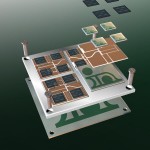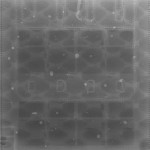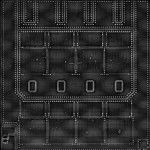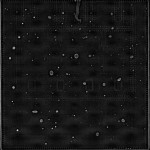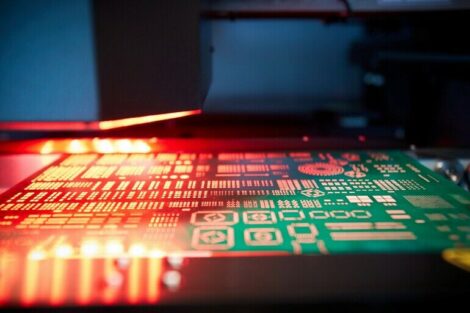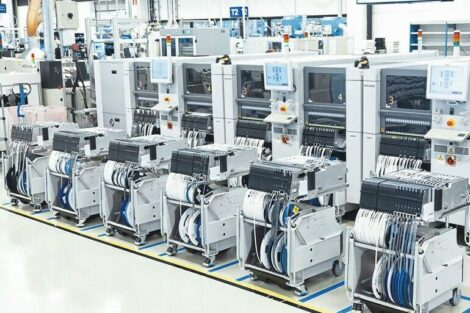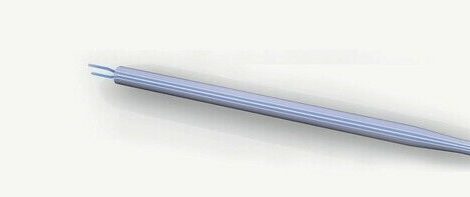Wind energy, solar electricity, electro mobility … these catchwords are met continually and never before had such a global importance as today. In addition to all the advantages and safety that were enabled by these development tendencies, they put high demands to the development of required electronic components. In particular in the area of electro mobility, there is the necessity of miniaturized power electronics complementing the actual control tasks for electronic and hybrid drives. Due to the economic production of large yields, the manufacturing technology faces new challenges. This also includes required test methods to enable a fault-free but efficient quality assurance. High level inspection technologies, e.g. 3D x-ray analysis, are required and also face new challenges.
Göpel electronic, Jena (Germany)
The direct mounting of dies (e.g. IGBT or diodes) on a basis substrate has established as technology for producing integrated power electronics. The required electric connections are implemented by a large soldering area on the dies’ bottom sides and additionally by parallelised bond connections at their top sides. Very often, the basis substrate is soldered on a heat sink to lead away power dissipation, occurring during the regular operation of such modules. In the case of utilising such power control, e.g. for electronic drives of hybrid vehicles, the heat sink is additionally integrated in the vehicle’s cooling water circuit.
Open doors for excess heat
Power modules must be highly reliable and of long product life. That’s why maximum heat transfer must be guaranteed from the soldered die to the heat sink. The required thermal coupling is mainly achieved by a low thermal resistivity. Voids play a decisive role in this quality criterion within solder connections. Especially in large-scale solder joints, which may cover an area of up to 25 cm², the development of enclosed gases is difficult. As a frequent result, voids of different sizes and positions remain within this connection. In terms of thermal coupling, they may lead to the module‘s malfunction or even destruction in the operation mode. Quality control during the production process therefore is imperative.
Making the invisible visible
In the current state of technology, there are few opportunities to detect voids after the soldering process. A 100 % test within the production cycle even limits the selection of test technologies. Acoustic microscopy as well as computer tomography by means of an x-ray analysis system can be excluded for an efficient utilisation because of the time scales required for image capturing and subsequent evaluation.
In principle, the x-ray technology has proven to be effective for solder joint analysis on electronic assemblies, and has widely been used for quality control in the inline production process. But in the present case this inspection technology faces new challenges:
- Safe and high-res detection of voids in relevant solder joints
- Separation of voids in various layers
- Determination of quality affecting parameters for each solder layer
- Inspection in mounted state (e.g. with heat sink)
- 100% inspection in the production cycle
It’s quite easy to recognise that common 2D and 2.5D x-ray inspection systems are unsuitable for such test tasks. A view to an orthogonally or angularly radiated PCB makes it clear. In the taken pictures voids are visible but cannot be referred to a specific solder layer. But in particular this classification is of the highest importance because significantly different quality criteria are set for the thermal coupling of die and basis material as well as basis material and heat sink. Consequently, an evaluation of voids detected with a 2D or 2.5D method would lead to fault escapes or massively increased false rejects of the device.
Skilful inspection bit by bit
The only remaining method for quality assurance is the 3D x-ray inspection technology by complete reconstruction of the single layers. This methodology also faces particular challenges in the actual case, and not every system is able to solve this sophisticated test task. A critical reason is the already mounted heat sink that features structures for a possibly large contact surface with the cooling medium especially for the integration in a cooling water circuit. These structures cause different x-ray absorptions being visible as a fault in the reconstructed result image. Similarly, solder joint sizes as well as the undefined position and dimension of voids effect such artefacts when utilising standard reconstruction methods.
Due to the mentioned requirements, the 3D x-ray inspection system OptiCon X-Line 3D was enhanced to enable adapted image capturing and a layer-wise reconstruction.
In the further inspection process, the captured images allow for an automatic void detection in each layer including classification in terms of quality parameters separately determined for the respective layers. Furthermore, there is the opportunity to survey and evaluate faults at a verification station.
In addition to the mentioned opportunities, the AXI system OptiCon X-Line 3D suits for the inline inspection of double-sided equipped PCBs. In just one run all PCB layer information is available and can be individually reconstructed for automatic analyses. This characteristic provides the opportunity to break down critical solder joints (e.g. under BGAs) into single layers for detailed automatic analysis. Hence, a complete 3D x-ray inspection in the production cycle provides the basis for a comprehensive quality analysis and the highest production quality.
productronica, A1.239
ZUSAMMENFASSUNG
Windenergie, Solarstrom oder Elektromobilität sind Schlagworte die eine zunehmende Bedeutung haben. So wird speziell im Bereich Elektromobilität Elektronik benötigt, welche die Aufgaben für den Elektro- und Hybridantrieb kontrolliert. Dies beinhaltet Testmethoden, die einen völlig fehlerfreien und effizienten Prozess garantieren.
L’énergie éolienne, le courant solaire ou la mobilité électrique sont des mots-clés qui prennent de plus en plus de signification. Ainsi, c’est dans le secteur de la mobilité électrique tout spécialement que l’on a besoin d’une électronique contrôlant les tâches d’entraînement électrique et hydrique. Cela inclut des méthodes de test qui garantissent un processus efficace et sans aucune erreur.
Share:




